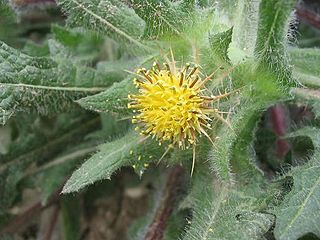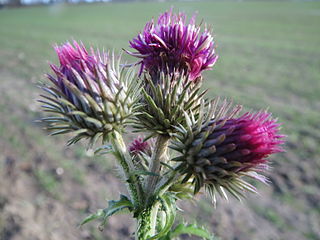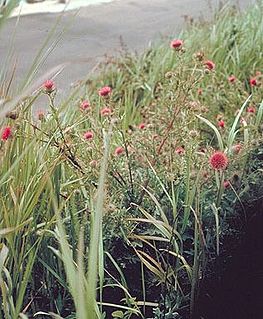
Carduus nutans, with the common names musk thistle, nodding thistle, and nodding plumeless thistle, is a biennial herb in the Asteraceae—sunflower family. It is native to regions of Europe and Asia.

Onopordum acanthium is a flowering plant in the family Asteraceae. It is native to Europe and Western Asia from the Iberian Peninsula east to Kazakhstan, and north to central Scandinavia, and widely naturalised elsewhere, with especially large populations present in the United States and Australia. It is a vigorous biennial plant with coarse, spiny leaves and conspicuous spiny-winged stems.

Onopordum, cottonthistle, is a genus of plants in the thistle tribe within the Asteraceae. They are native to southern Europe, northern Africa, the Canary Islands, the Caucasus, and southwest and central Asia. They grow on disturbed land, roadsides, arable land and pastures.

Thistle is the common name of a group of flowering plants characterised by leaves with sharp prickles on the margins, mostly in the family Asteraceae. Prickles can also occur all over the plant – on the stem and on the flat parts of the leaves. These prickles are an adaptation that protects the plant from being eaten by herbivores. Typically, an involucre with a clasping shape similar to a cup or urn subtends each of a thistle's flowerheads.

Centaurea calcitrapa is a species of flowering plant known by several common names, including red star-thistle and purple starthistle. It is native to Europe but is rarely found there, it is known across the globe as an introduced species and often a noxious weed. The species name calcitrapa comes from the word caltrop, a type of weapon covered in sharp spikes.

Cnicus benedictus, is a thistle-like plant in the family Asteraceae, native to the Mediterranean region, from Portugal north to southern France and east to Iran. It is known in other parts of the world, including parts of North America, as an introduced species and often a noxious weed. It is the sole species in the monotypic genus Cnicus. Other species once included in the genus have largely been reclassified to Cirsium, Carduus, and Centaurea.

Carduus acanthoides, known as the spiny plumeless thistle, welted thistle, or plumeless thistle, is a biennial plant species of thistle in the sunflower family (Asteraceae). The plant is native to Europe and Asia and introduced in many other areas, where it is sometimes considered an invasive species.

Carduus tenuiflorus, known variously as slender-flower thistle, sheep thistle, shore thistle, slender thistle, winged plumeless thistle, winged slender thistle, and winged thistle) is a species of thistle.

Carthamus lanatus is a species of thistle known as woolly distaff thistle, downy safflower or saffron thistle. It is closely related to safflower, which is in the same genus. This annual plant is a native of the Mediterranean Basin, but it is familiar in other places where it was introduced and has become a noxious weed, such as in parts of North America and southern Australia with similar climates. This is a spiny, glandular, woolly plant, which often looks like it is covered in spiderweb due to its fine tangled fibers. It has a pale stem which may reach a meter in height, and rigid, pointed, very spiny leaves. The flower head has many long, sharp phyllaries that can be up to several centimeters long, and often bend backwards (recurved). The disc florets are bright yellow. One plant can produce many stems which mat together due to their spininess and form a small thicket. The fruit is an achene about half a centimeter long with many rigid pappus scales.

Cirsium neomexicanum is a North American species of thistle known by the common names New Mexico thistle, powderpuff thistle, lavender thistle, foss thistle and desert thistle.

Rhinocyllus conicus is a species of true weevil. It is best known as a controversial agent of biological pest control which has been used against noxious thistles in the genera Carduus, Cirsium, Onopordum, and Silybum.

Onopordum illyricum is a species of thistle known by the common name Illyrian thistle, or Illyrian cottonthistle. It is native to southwestern Europe, but has been introduced into Australia and California, where it has become a noxious weed.

Cirsium andersonii is a North American species of thistle known by the common names Anderson's thistle and rose thistle. It is native to California, Oregon, and Nevada, where it grows in the woodlands and forest openings of the local high mountain ranges, including the Sierra Nevada and the southern Cascade Range. It has also been reported from Idaho.

Cirsium andrewsii is an uncommon species of thistle known by the common name Franciscan thistle. It is endemic to California, where it is known from the coastline of the San Francisco Bay Area from Marin to San Mateo Counties. There are also reports of isolated populations in the Klamath Mountains and in the Sierra Nevada.
Cirsium ciliolatum is a species of thistle known by the common name Ashland thistle. It is endemic to the Klamath Mountains, where it is known from only a few occurrences in Jackson and Josephine Counties in Oregon, as well as neighboring Humboldt and Siskiyou Counties in California. It is related to Cirsium undulatum and may be more accurately described as a variety of that species.
Cirsium crassicaule is a species of thistle known by the common name slough thistle. It is endemic to the San Joaquin Valley of California, where it is known primarily from freshwater wetlands. It has been found in only a few locations in Kern, Kings, and San Joaquin Counties.

Cirsium cymosum is a North American species of thistle known by the common name peregrine thistle. It is native to the western United States, where it has been found in California, Oregon, Nevada, Utah, Idaho, Wyoming, and Montana.

Cirsium loncholepis is a rare species of thistle known by the common name La Graciosa thistle. It is endemic to California, where it is known from about 15 remaining occurrences in wetlands where southwestern San Luis Obispo County borders northwestern Santa Barbara County. It grows in coastal scrub and sand dunes, marshes, and moist grasslands in the watersheds of local rivers, including the Santa Maria River. It is a federally listed endangered species.

Cirsium mohavense is a species of thistle known by the common names virgin thistle and Mojave thistle. It is native to the southwestern United States, where it grows in moist areas in otherwise dry habitat, such as desert springs. It is most common in the Mojave Desert, found also in the southern Great Basin and other nearby regions of California, Nevada, western Arizona, and southwestern Utah.

Cirsium remotifolium is a species of thistle known by the common name fewleaf thistle. It is native to the western United States, including the Pacific Coast and possibly as far east as the Rocky Mountains, depending on which populations are treated as part of the species. It is sometimes part of the serpentine soils flora. This native thistle is a perennial herb growing up to about 1.5 meters tall. The leaves are borne on spiny petioles and are toothed or lobed, the lowest leaves at the base of the stem reaching 50 centimeters in length. The inflorescence is made up of clustered flower heads which are lined with spiny phyllaries. The head is filled with white or purple flowers up to 2.5 centimeters long. The fruit is an achene a few millimeters long topped with a pappus up to about 2 centimeters in length.


















